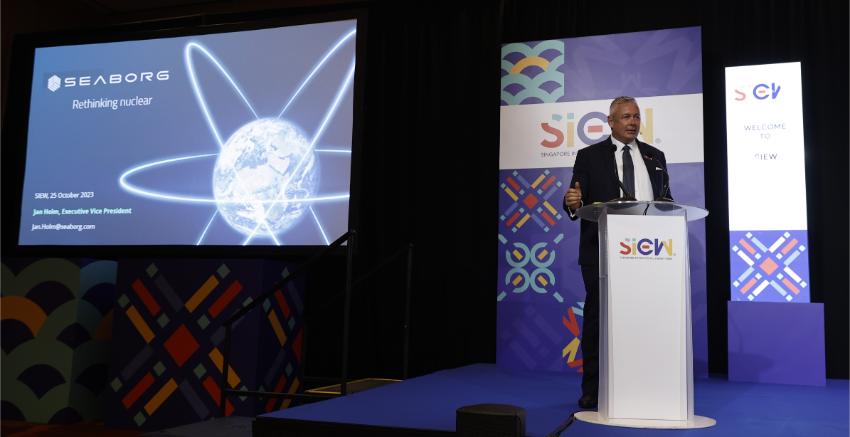Seaborg makes a case for how Molten Salt Reactors can bolster the energy, food, and water security of countries like Singapore. R Preyadharisene reports.

In the realm of sustainable energy, there are game-changers, and then there are those that redefine the rules of the game. Mr Jan Holm, Executive Vice President, Seaborg Technologies, believes his company's nuclear innovation could have a profound impact on the energy transition.
At the SIEW TechTable on 25 October, on the topic of Nuclear: Revolutionising Energy: Small Modular Nuclear Reactors & Floating Solutions, he shared the genesis of Seaborg. The company's journey commenced with a conversation in 2015 between scientists from the Danish Technological University, asking: "How can we decarbonise? How can we really make something that makes a difference?"
The answer to that question laid the foundation for what Seaborg stands for today. This demanded a technology that could scale fast and was cheap—in fact, "cheap enough that it is so competitive with typical resources like coal and other fossil fuels", said Mr Holm.
Thus, the vision of Seaborg was born, rooted in the small modular reactors developed by Glenn Seaborg in the 1950s – 60s. The company's business model also involved working with shipyards and partners to scale fast.
Powering every household in Singapore
The potential of Seaborg's technology became evident when Mr Holm revealed that each of the company's shipyards can build 4,800 megawatts worth of reactors in a single year—more than the energy consumption of most countries. Transporting the reactors is a breeze since each reactor can fit into a standard 20-foot container. What's more, six of these reactors could power every household in Singapore.
Using the shipyard’s ability to mass produce again and again akin to an assembly line, he said a timeline of "three years from signature to delivery” is a realistic expectation.
From an energy security and access point of view, the 24-year lifespan of each reactor, with zero need for refuelling, stands as another affirmation of the appeal of Seaborg’s technology.
Revolutionary safety profile: The Molten Salt Reactor
Addressing a critical concern over nuclear reactor accidents, Mr Holm emphasised the revolutionary safety features of Seaborg's Molten Salt Reactor technology. "In the worst-case scenario and if (the molten salt coolant) escapes the reactor, it solidifies within 60 seconds… It means from a safety perspective, it will be contained. Even if it drops into the water, it doesn’t dissolve in water, and you will be able to clean it up."
Mr Holm shared that Molten Salt Reactors differ from conventional pressurised water reactors in the choice of coolant, thus giving the former an edge in terms of safety.
Additionally, Seaborg’s technology features a built-in negative feedback loop. If the temperature starts to rise, the efficiency of the fusion reaction drops, further enhancing safety. Notably, this technology cannot be weaponised, and Seaborg takes responsibility for collecting spent nuclear fuel for recycling, thus relieving host countries of the burden of having to manage and store radioactive waste.
The case for Singapore, and meeting unique needs
Mr Holm displayed a profound understanding of Singapore's distinctive circumstances, marked by land constraints and limited indigenous resources such as energy, food and water. He brought home the point by illustrating how Seaborg’s technology could address these fundamental needs.
"Someone I met at a conference said that we need three things to survive; we need food, we need energy, and we need water. Nuclear can desalinate water, free up land for vertical farming since you don’t need as much land for energy, and finally you can produce ammonia for fertiliser to make food.” This could help fortify the country against challenges like those faced during the COVID-19 pandemic, he added.
Seaborg's low carbon vision: Small but impactful
Beyond basic energy access, and bolstering water and food security, Mr Holm underscored that nuclear energy could play a pivotal role in reducing carbon emissions from cement production which is typically coal reliant. He explained that nuclear energy's heat and electricity generation can produce hydrogen, which, when combined with CO2, results in methanol. This methanol can then replace coal in the cement-making process, significantly lowering carbon emissions.
While his company is relatively small, Mr Holm emphasised that the company is scientifically driven and works with credible and experienced partners such as Korea Hydro & Nuclear Power.
Seaborg’s story, not unlike others at this year’s SIEW TechTable, is a testament that companies, regardless of size, play a critical role in propelling innovation—a key factor in unlocking new low carbon energy technologies.